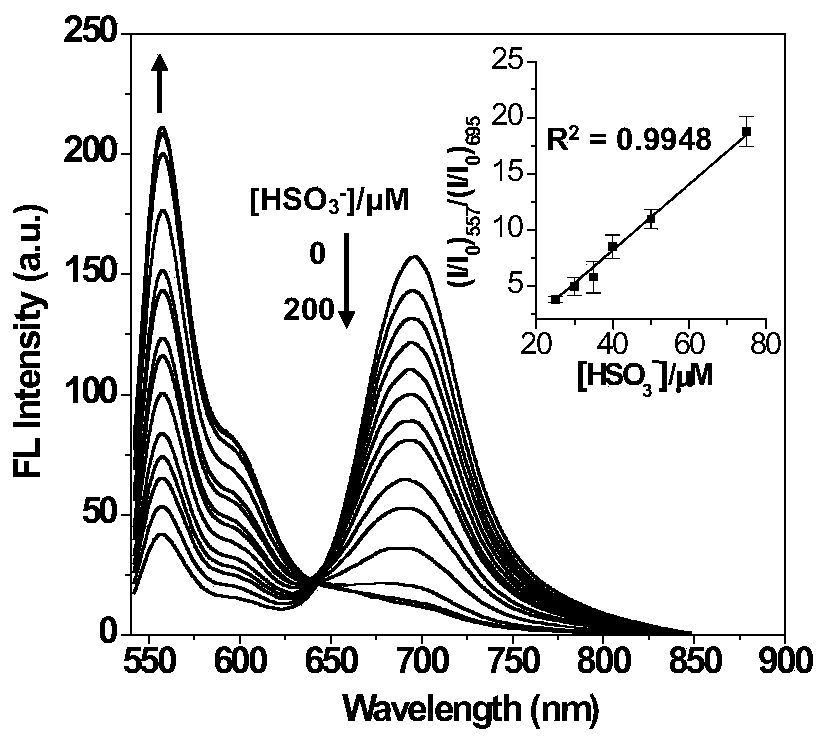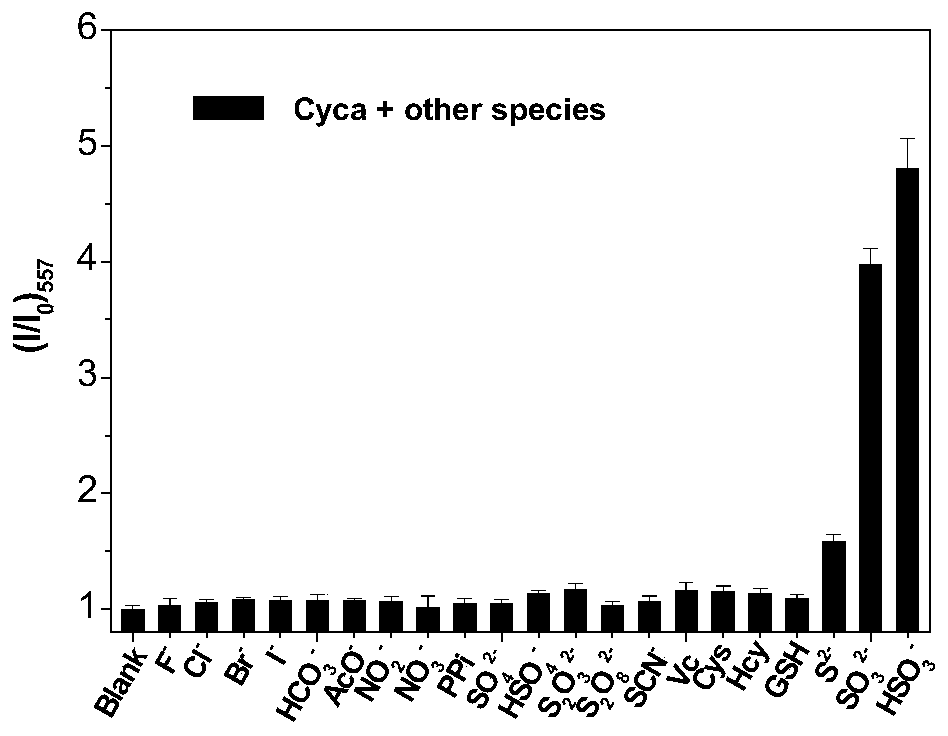Near-infrared fluorescent probe for bimodal detection of sulfur dioxide, and preparation method and application thereof
A technology of fluorescent probes and sulfur dioxide, applied in chemical instruments and methods, fluorescence/phosphorescence, and material analysis by observing the influence of chemical indicators, etc., can solve the problem of single signal output mode, false positive signal output, and probe distribution Uneven problems, to achieve broad application prospects, reduce light damage, and enhance the effect of signal-to-noise ratio
- Summary
- Abstract
- Description
- Claims
- Application Information
AI Technical Summary
Problems solved by technology
Method used
Image
Examples
Embodiment 1
[0037] Embodiment 1: the synthesis of intermediate 1
[0038]
[0039] Compound 2,3,3-trimethyl-3H-indole (9.87g, 0.062mol) and compound iodoethane (14.5g, 0.093mol) were added to a 150mL round bottom flask, and then 50mL of anhydrous acetonitrile was added , The reaction was stirred at 85°C for 24h. After cooling to room temperature, the crystals were precipitated, filtered with suction, and the filter cake was washed 3 times with 3×10 mL ice ethanol to obtain Intermediate 1.
Embodiment 2
[0040] Example 2: Synthesis of near-infrared fluorescent probes
[0041]
[0042] Intermediate 1 (1g, 3.17mmol) and 4-(dimethylamino) cinnamaldehyde (0.67g, 3.8mmol) were dissolved in 30mL of absolute ethanol, and then 100μL (2 drops) of piperidine was added as a catalyst, at 80 The reaction was stirred at ℃ for 8 h, cooled to room temperature, and the solvent was removed by a vacuum rotary evaporator. The obtained crude product was purified by silica gel column chromatography, and the eluent ratio was dichloromethane / ethyl acetate / methanol=40 / 60 / 1( v / v) to obtain the target product.
[0043] Note: The synthesis of each compound in the general formula of the probe can be carried out according to the synthesis steps of the above-mentioned probe.
Embodiment 3
[0044] Embodiment 3: fluorescent probe to SO in water system 2 Visual colorimetric detection of
[0045] Take the fluorescent probe prepared in Example 2 and dissolve it in ethanol to configure a concentration of 1×10 -3 mol / L stock solution. Measure 2 mL of the probe stock solution and add it to a 100 mL volumetric flask, and make the volume to 100 mL with HEPES buffer solution (10 mM, pH=7.4), so that the final concentration of the probe is 20 μM. Add different concentrations of NaHSO to the probe solution 3 (SO 2 donor) solution to a final concentration of 0-150 μM. Determination of adding different concentrations of SO 2 Finally, the probe absorbs the peak intensity and wavelength changes, and uses a digital camera to record the probe and SO 2 The color change of the solution before and after the reaction. Photos of UV-Vis absorption spectrum and color change of fluorescent solution are shown in figure 1 . As shown in the figure, the probe has a strong absorption ...
PUM
 Login to View More
Login to View More Abstract
Description
Claims
Application Information
 Login to View More
Login to View More - R&D
- Intellectual Property
- Life Sciences
- Materials
- Tech Scout
- Unparalleled Data Quality
- Higher Quality Content
- 60% Fewer Hallucinations
Browse by: Latest US Patents, China's latest patents, Technical Efficacy Thesaurus, Application Domain, Technology Topic, Popular Technical Reports.
© 2025 PatSnap. All rights reserved.Legal|Privacy policy|Modern Slavery Act Transparency Statement|Sitemap|About US| Contact US: help@patsnap.com



